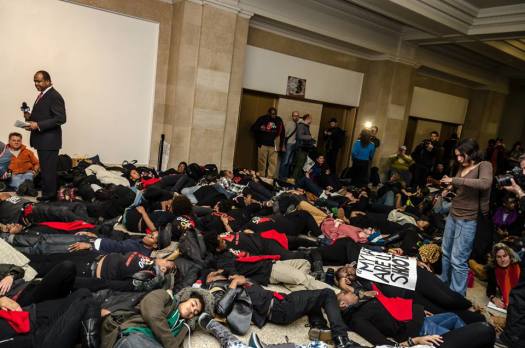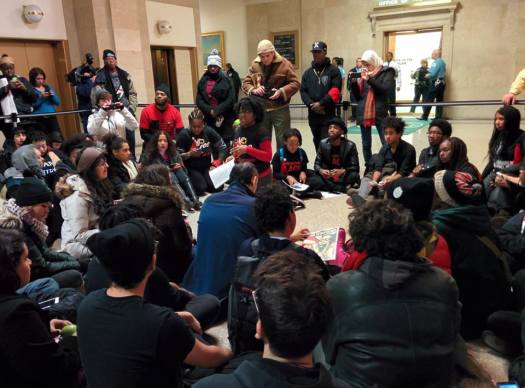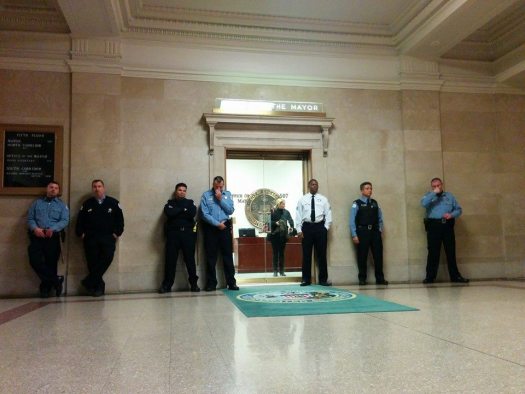Send White People to Jail: Protest in the Era of Black (Mass) Incarceration
On Tuesday, young people from BYP 100‘s Chicago chapter organized and led an occupation of City Hall. Sitting and standing in front of Mayor Rahm Emanuel’s offices, members of Chicago BYP 100 chanted, facilitated teach-ins about the PIC, staged a die-in and kept healing circles.
BYP 100 members were joined in this action by dozens of supporters of all ages, races, genders and more. By all accounts, it was a beautiful and affecting action for those in attendance.
The protesters intended to stay at City Hall for 28 hours to dramatize the fact that “every 28 hours in this country, a black person is killed by a police officer, security officer or a self-appointed vigilante.”
City Hall closes officially at 5 pm. During the entire day beginning at 9 am, protesters were monitored by police officers who guarded the entrance of the Mayor’s offices.
Starting at around 4:15 pm, preparations began to expel the protesters from City Hall. The front doors were closed with only the revolving doors remaining accessible to the public. Existing officers got reinforcements when other cops began to arrive. At around 5:30 pm, protesters began receiving warnings from the Chicago Police Department (CPD) to leave the building. I was following events on social media from my office that day. I began seeing tweets and Facebook posts from friends broadcasting that arrests were imminent. In response, I tweeted:
Jesus, looks like we're going to have to raise some bail funds ASAP.
— Side-Eye (Forever) (@prisonculture) November 26, 2014
Immediately, a twitter follower (who subsequently decided to erase their tweet) interjected with “Fuck bail, we need to resist…” or something to this effect.
I responded pointedly with the following tweet:
.@dingalingy55 Sorry. Doesn't work that way. It's 2014. We're in era of black mass incarceration. Arrests, jail don't mean the same things
— Side-Eye (Forever) (@prisonculture) November 26, 2014
At around 6:30 pm, the CPD issued a final warning. Now everyone who defied their order would be subject to arrest.
Just issued final warning. #Chi2Ferguson @BYP_100 pic.twitter.com/xIhFrm2V6X
— Monica Trinidad (@monicatea2) November 26, 2014
The leaders of BYP 100 met to discuss how to proceed. When they returned, they announced that their members had collectively decided to comply with the CPD’s dispersal order to avoid arrests. They tweeted:
“We made a collective decision to not take arrest tonight. We will deepen our campaign work and we will be back. #every28hours #BlackLivesMatter”
In announcing the decision to those assembled, Charlene Carruthers the National Coordinator of BYP 100, said:
.@CharleneCac "Let's be clear, the arrest of black bodies is not a simple thing." #Chi2Ferguson via @monicatea2 pic.twitter.com/ATGvyFBmeu
— Occupy Chicago (@OccupyChicago) November 26, 2014
My mind has been racing. I’m thinking about our tactics and strategies of protest and resistance in an era of black (mass) incarceration. And here’s the conclusion that I have reached: White people should go to jail.
In reviewing the history of the Black freedom movement, the prominent leaders were repeatedly jailed: Martin, Bayard, Diane, Fannie, Rosa, Huey, Stokely, H. Rap, James Farmer, John Lewis… The list is so long as to seem interminable. In fact, Malcolm X makes the point in a speech that:
“You can’t be a negro in America and not have a criminal record. Martin Luther King has been to jail. James Farmer has been to jail. Why you can’t name a black man in this country who is sick and tired of the hell that he’s catching who hasn’t been to jail.”
Henry David Thoreau is credited with having said that: “In an unjust state the only place for a man is in jail.” Bayard Rustin reinterpreted that concept and wrote that “it is an honor to face jail for a just cause.” Dr. King embodied this idea in his repeated trips to jail from the mid-50s to the mid-60s. In his famous “Letter from A Birmingham Jail,” he wrote:
“One who breaks an unjust law must do so openly, lovingly, and with a willingness to accept the penalty. I submit that an individual who breaks a law that conscience tells him is unjust and who willingly accepts the penalty of imprisonment in order to arouse the conscience of the community over its injustice, is in reality expressing the highest respect for law.”
For King, Parks and the young people from SNCC and CORE, going to jail was about civil disobedience. It was a strategy for gaining public support and to claim the moral high ground. For King, direct action should be nonviolent in nature even when met with violence. In 1964, a year after the March on Washington and four years before Dr. King was assassinated, there were 81,099 Americans in prison. 27,191 were black. In “Why We Can’t Wait,” King addressed black incarceration:
“Jailing the Negro was once as much of a threat as the loss of a job. To any Negro who displayed a spark of manhood, a southern law-enforcement officer could say: ‘Nigger, watch your step, or I’ll put you in jail.” The Negro knew what going to jail meant. It meant not only confinement and isolation from his loved ones. It meant that at the jailhouse he could probably expect a severe beating. And it meant that his day in court, if he had it, would be a mockery of justice.'”
Dr. King links the jailing of black people in his era with the State’s abiding interest in emasculating black men. He also underscores the brutality of imprisonment for black people. He goes on to write:
Since nonviolent action has entered the scene, however, the white man has gasped at a new phenomenon. He has seen Negroes, by the hundreds and by the thousands, marching toward him, knowing they are going to jail, wanting to go to jail, willing to accept the confinement, willing to risk the beatings and the uncertain justice of the southern courts.
There were no more powerful moments in the Birmingham episode than during the closing days in the campaign, when Negro youngsters ran after white policemen, asking to be locked up. There was an element of unmalicious mischief in this. The Negro youngsters, although perfectly willing to submit to imprisonment, knew that we had already filled up the jails, and that the police had no place left to take them.
When, for decades, you have been able to make a man compromise his manhood by threatening him with a cruel and unjust punishment, and when suddenly he turns upon you and says: “Punish me. I do not deserve it. But because I do not deserve it, I will accept it so that the world will know that I am right and you are wrong,” you hardly know what to do. You feel defeated and secretly ashamed. You know that this man is as good a man as you are; that from some mysterious source he has found the courage and the conviction to meet physical force with soul force.
[…]
So it was that, to the Negro, going to jail was no longer a disgrace but a badge of honor. The Revolution of the Negro not only attacked the external cause of his misery, but revealed him to himself. He was somebody. He had a sense of somebodiness. He was impatient to be free. (King, 1964, pp.26-30)
That some black people were willing to submit themselves to mass arrests and imprisonment to protest the conditions of their oppression was an innovation of the modern black freedom movement. In 1965, Coretta Scott King was interviewed by Jet Magazine as she left Atlanta to visit her husband who was jailed in Selma. She spoke of her desire to participate in the jail-ins:
“I have never been arrested before. I really feel, sometimes, a little bit — shall I say, deprived of the experience of going to jail. I want to have that experience. Many times, in a spiritual sense I’ve experienced it, but not physically. It would help to strengthen my own convictions. I have often talked to him (Dr. King) about going to jail. He has agreed to it, but has always felt that the time was not right — often because of the children.
“I first wanted to go to jail when we were in India (in 1959) and I learned that so many Indian women had been to jail in their struggle. (King has patterned his public actions after Indian leader Mohandas Gandhi.) So few of us (women) in the U.S. had been to jail at that time. Learning how many of those persons went and stayed for long periods and meeting older people who knew Gandhi made me realize that if I didn’t go to jail during this revolution, I will have missed something.”
Contemplating arrest in Selma, she concluded: “Since I haven’t gone (to jail) before, this is as good a time as any — perhaps the best since I grew up in Alabama — to suffer for my people…in Alabama, on the soil of Alabama.
Besides illustrating that Coretta King subsumed her own ambitions to support her husband in his work, Mrs. King’s words describe her interest in more actively participating in nonviolent resistance (putting her actual body on the line by going to jail).
It wasn’t only the leaders of the modern Black freedom movement who went to jail as a form of protest. Young people across the country were instrumental in the development and execution of the jail-in strategy. The story of the Friendship Nine is unknown to many but it shouldn’t be:
“On the morning of January 31, 1961, a group of eighteen African-American civil rights demonstrators (thirteen men and five women), most of whom were students at Friendship College, converged on the McCrory’s 5-10-25¢ Variety Store in downtown Rock Hill. Authorities had been notified ahead of time that there would be protests and they were on duty by 8:30 AM in case of trouble. Initially the protesters marched up and down the street carrying protest signs. Then, male demonstrators went inside the store and ten of the thirteen young men sat down at the counter and refused to leave.”
When the young people were arrested, they were ordered to pay a $100 fine or be sentenced to 30 days of hard labor. The young Freedom Fighters decided to serve the 30 days of hard labor. This was the beginning of the codification of a “jail-in” strategy in the black freedom movement. Even while they were locked up, the SNCC students protested and brought attention to the brutal conditions of their incarceration. Claybourne Carson, author of In Struggle: SNCC and the Black Awakening of the 1960s, suggests that:
“For students, the Rock Hill “jail-in” was an attempt to revive the student movement by returning to the moral principle of non-cooperation with evil that was the basis of passive resistance (p.32).”
In the summer of 1961, hundreds Freedom Riders including James Farmer, James Bevel and Stokely Carmichael were imprisoned at Parchman Prison Farm in Mississippi. They had rejected paying a $200 fine and chose prison instead. The jail-ins and jail no bail strategies served several purposes. Protesters would fill the jails by the 100s to stretch the resources of the state while simultaneously withholding bail funds to the system. These mass arrests were also meant to symbolically depict an unwillingness to acquiesce to the status quo. For more context on this strategy, watch an excerpt from the film “Jail No Bail:”
Today, times are different. In 2013, there were 1,574,700 prisoners in the U.S. (state and federal facilities excluding jails). Over 550,000 were black. Black men were 6 times as likely to be incarcerated as white men in 2013 while black women were 2.2 times as likely to be imprisoned as whites. Sociologist Lawrence Bobo explains that “[t]he rise of mass incarceration has had a disproportionate effect on African-American communities, especially those that are low-income.” He adds that “[w]e are at a point where 1 in 15 black men is in jail or prison – and for those between the ages of 20-34, the rate is 1 in 9.” These numbers suggest that incarceration presents a different kind of threat to black people in 2014 than it did in 1964.
Rose Brewer and Nancy Heitzeg (2008) make the case that “[t]he post-civil rights era explosion in criminalization and incarceration is fundamentally a project in racialization and macro injustice.” Loic Wacquant has characterized black hyperincarceration as “a new fourth state of racial oppression.” And Michelle Alexander calls it the “New Jim Crow.” All of this suggests that seeing black people locked in cages has become normalized. In fact, during a recent Ferguson solidarity march in Boston, protesters stopped at a local jail. Here’s an account of what happened in the Huffington Post:
“Bostonians turned out Tuesday night to show solidarity with protesters nationwide, upset over the decision not to indict Ferguson police Officer Darren Wilson for killing unarmed African-American teenager Michael Brown. But the protest in Boston had a twist: Marchers stopped at a local jail to stand with the inmates there.
According to the Boston Globe, approximately 1,400 people marched to the South Bay House of Correction. Protesters were reportedly chanting, “We see you,” and “Black lives matter.”
The South Bay facility houses adult male and female inmates convicted of crimes with a sentence of 2.5 years or less.”
Many on social media were heartened by this encounter and they found the chant “We see you” to be particularly poignant. Sadly, I have written many times about the invisibility of prisoners. Unfortunately, I think that most people are perfectly comfortable with disappearing prisoners, particularly if they believe that they are black. In fact, a recent study that made some news found that telling white people about racial disparities in prison made them more likely to support harsher punishment. In other words: “[R]eminding white people of racial disparities in the prison population led them to favor policies that contribute to those very disparities.” As I have said before, blackness is a repellent to empathy and frankly Black prisoners need a lot more than to be “seen.” Black prisoners need to be freed. Only a very few people are talking and more importantly ACTING on that charge.
Different historical moments call for innovations of organizing strategies and tactics. I don’t believe that mass arrest & jailing of black people will move most other Americans or appeal to their moral consciences. In fact, I think that this tactic applied in 2014 is likely to delight many Americans. The spectacle of black (mass) arrest plays into the fantasies that some white people have of disappearing black people from society altogether. Many people already believe that prison is black people’s natural habitat. It’s where we belong as un-humans if we can’t be killed by the state.
Additionally, what does it even mean to “fill the jails” in Chicago where Cook County Jail is overcapacity holding over 10,000 people (mostly black) a day? How would sending 100 or (generously) 500 black protesters to CCJ for a few hours make a difference? If we organized 1,000 black protesters to be jailed at CCJ (& who refused to be bonded out), this could have some impact on County resources. But that’s not the current strategy.
Then there is the thorny issue of raising and posting bail for protesters when there are 19 year old young black women sitting in Cook County jail this every minute on minor drug charges or on bogus resisting arrest charges or on assault charges who need only $1,000 to get out. Shouldn’t they be the ones bailed out first if we bail anyone out? Honestly, we need to focus on freeing as many people from the criminal punishment system as we can right now. If we launched campaigns to abolish cash bonds altogether, this would have a very salutary effect for thousands and millions of people over time. Instead when black protesters are locked up, we have to tap our networks (already stretched thin financially) to raise money to give to the already oppressive and unjust criminal punishment system. We are feeding the beast we need to dismantle. This makes zero sense to me in this historical moment.
I still believe, however, in the importance and value of civil disobedience. Hence, I propose a strategy of white (mass) arrest and jailing across the country to protest racial oppression. This is a useful role for white co-strugglers to play in the ongoing struggle for black freedom and for the liberation of all people. So let’s send white people to jail for justice… It’s more likely to bring the desired attention to issues of racial justice and to engender empathy from other white people.



